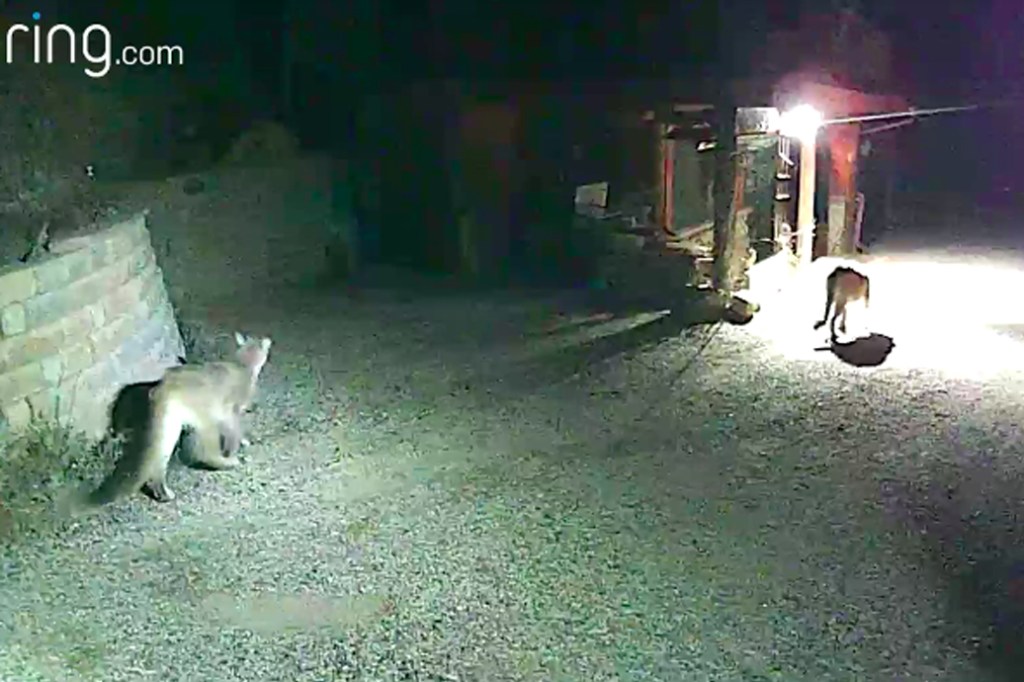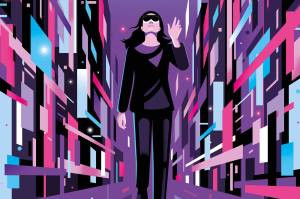On the grainy video, the first cat trips a motion detector. A light suddenly bursts on, and anyone watching the video feed can now see the side of a house, a driveway, a white pickup truck. Behind the first cat, a second cat appears, and then a third, both of whom seem more perturbed by the light. They leap up a wall at what appears to be the back of the house, disappearing into the night while a fourth cat and then a fifth appear, following the path of the first cat, who lumbers casually away and out of view. The timestamp on the bottom right-hand corner of the video footage reads 1:33 in the morning.
The cats on the video are not house cats; their long, slouching bodies are those of the American cougar, also known as the catamount, puma, or mountain lion. It’s rare for five of this usually solitary cat to show up together, and to the human observer, it’s more than a bit terrifying. But, there they were: captured in remarkable clarity on a Ring device, a doorbell video camera manufactured by a startup that Amazon acquired in early 2018 for $1 billion, in an apparently not-so-rural enclave of Boulder, Colorado. Thanks to a Ring feature that allows users to share select footage, Twitter user and Boulder-area mountaineer Matt Moniz shared the link to the clip of the mountain lions, attributing it to his neighbor. Within a few days, multiple local news outlets had requested to use the footage on air.
The cats probably have no idea they got so popular.
Doorbell cameras and outdoor security devices like Ring and the Google-owned Nest have been one of the more interesting and complex developments in the rise of the ‘internet of things’, the emergence of home and lifestyle devices that connect to the ever-growing digital cloud. They’ve fanned the flames of class tensions in cities like San Francisco, where they capture footage of delivery-box-stealing ‘porch pirates’ that promptly gets uploaded to Nextdoor, casting a light on the stark proximity between those with access to upward mobility in fast-gentrifying cities and the people that those cities have left behind. (In a twist of irony, the gentrification is often directly due to the success of the companies that make devices like Nest and Ring.) Ring, too, has raised alarms (pun intended) among civil rights and digital privacy organizations from its partnerships with hundreds of police departments.
But the likes of Ring and Nest also give us access to something that we may find heartening, unsettling, or a combination of both: never have we had such a clear way of understanding just how thin the divide is between what we think of ‘civilization’ and, well, wilderness. Ring’s motto is the hashtag ‘#AlwaysHome’. It’s meant to be reassuring. But in a twist, we’re not the ones who are ‘always home’. It’s not just the mountain lions in Boulder. It’s a bear opening car doors, which was such a popular video that Amazon put it in a commercial for Ring. It’s a moose snacking on a pumpkin on someone’s porch, which ended up getting promoted by Vivint, the camera’s manufacturer. It’s the partially-visible ‘mountain lion’ who sent a Washington, DC neighborhood into a frenzy when it appeared on a Ring camera, only to be debunked as a very large house cat.
Not long ago, if you wanted an easy way to capture unseen wildlife in your environs, you had to invest in a trail camera or trap camera. They’re not expensive and are easily obtainable on Amazon, but are still primarily a tool for hunting enthusiasts — you wouldn’t get one in the suburbs unless you were really hardcore about proving that you had a raccoon problem.
Nevertheless, trail cams have quite the internet following. A 2,500-member community on Reddit, /r/trailcam, consists almost exclusively of photos and videos of wild animals that have shown up on them at all hours of the day and night — coyotes, bobcats, deer, birds of prey. Compilations of unusual trail camera photos are a reliable staple of viral internet traffic, especially around Halloween (though it goes without saying that the ones with horned demons, creepy clowns, or Bigfoot in them are almost certainly staged or Photoshopped).
The rise of devices like Ring and Nest has brought this love of candid-camera critters into the mainstream, adding to an intense love of urban wildlife that runs the gamut from the ‘Pizza Rat’ internet sensation to devoted Meetup groups of New York City bird watchers. There’s something exciting about wildlife disrupting the communities that many of us thought were devoid of it. It’s entropy in its best form: wacky, usually harmless, and often cute and fuzzy. And when that entropy is delivered to us by the devices that are supposed to make our lives more orderly and reliable, all the better — small reminders that technology hasn’t consumed everything around us.
Of course, the presence of adorable wild animals (who doesn’t love the bear in the hot tub?) can put a furry face onto the very real issue of encroaching surveillance into our lives. The companies bringing us the internet of things don’t even need to invent mascots when they have ‘Mission Impossible Raccoon’. More than a few of us could be persuaded to buy doorbell cameras for no reason other than to indulge in the delight of the occasional opossum visitor (guilty as charged), but in our love of the liminal wild, we’re in effect purchasing one more lightbulb to illuminate the grid of a world under constant watch.
Perhaps more of us just need to get outside.



















